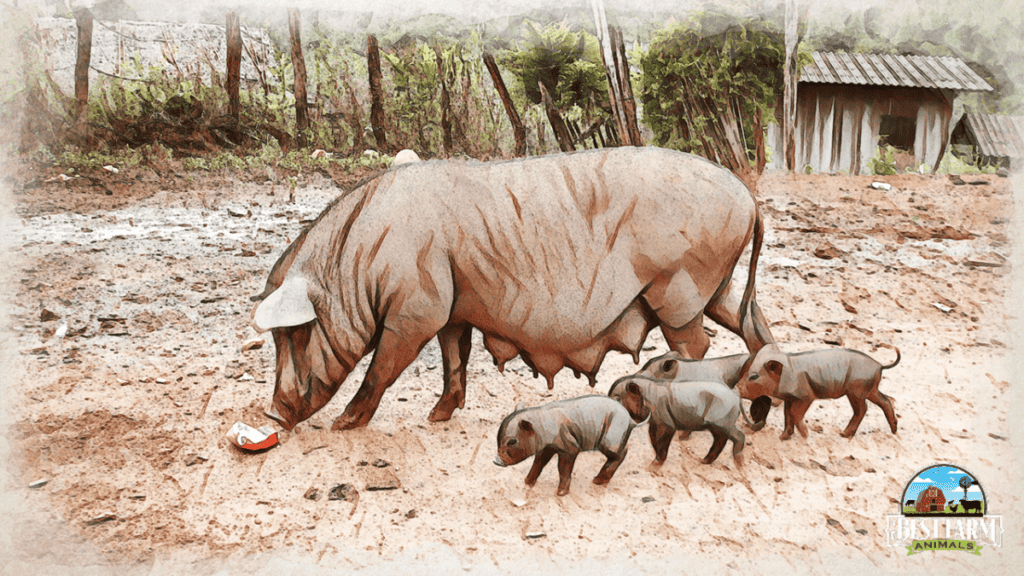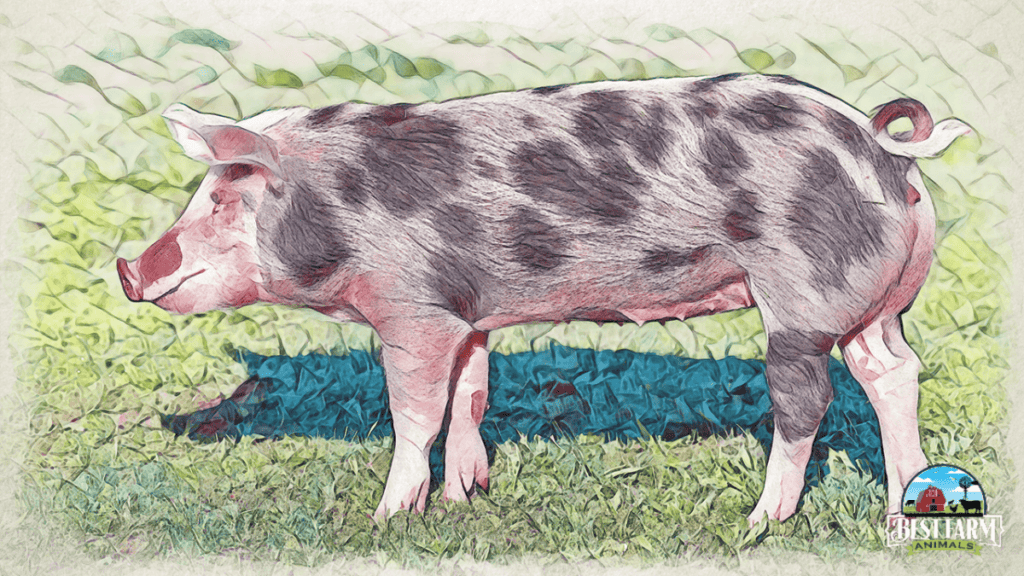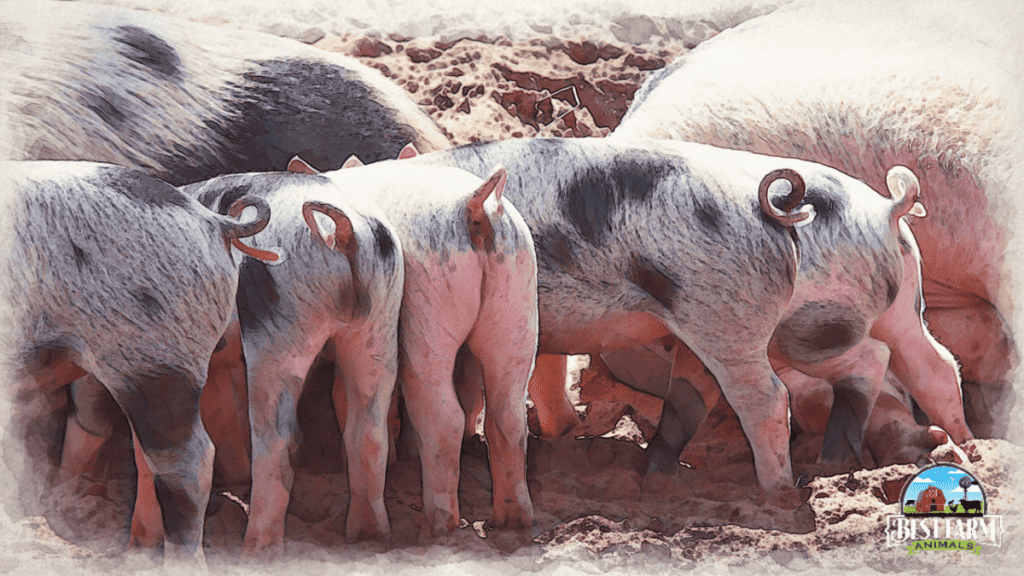Pigs have become one of the most loved animals in recent years. The growing popularity of pig decoration, pet pigs, and pig obsession has many people asking about pigs.
Some of the common questions include curiosity around why pigs have curly tails if the tail indicates a pig’s emotional health and other similar questions.
This article will answer those questions.
Why do pigs have curly tails? Many domestic pig breeds have curly tails because that trait was bred in domestic Chinese pigs over thousands of years. Wild pigs don’t have curly tails, except for a few wild pig breeds in China. It is likely that curly tails was not an intended trait bred by Chinese farmers, but was an accidental trait that was bred from pig fighting.

Pig Breeds From Certain Areas Have Curly Tails
Pig breeds that originated out of China have curly tails. It’s believed that any pig breed with at least some ancestors out of China will have a curly tail. In China, pig fighting has been a popular sport for thousands of years.
China is one of the few countries in the world that still allows pig fighting. During a pig fight, the pigs bite each other’s tails. As a result, pigs with curly tails are more likely to win the fight. Over thousands of years, the winning pigs, aka the survivors, developed curly tails.
Another theory is that Chinese farmers liked curly tails and purposefully bred curly tails into their pigs. This could have also been because some pigs were then used in pig fights.
Or, it could be a trait that was developed from wild hogs, a few of which have curly tails in China.

But, contrary to popular belief, China has wild hogs without curly tails as well.
The belief that all pig breeds with curly tails originate from China cannot be proved. For example, the Large White Pig originates from Yorkshire England, not China. Chinese pigs could have been used as some of the parent breeds of the Large White Pig, but that would have had to have been thousands of years ago.
There is no documentation on the breeds used to create the Large White Pig, but it was first recognized in the late 1800s as a breed originating out of the Yorkshire Pig. Once again, the origins of the Yorkshire pigs are not documented but was recognized in the 1700s as a pig breed.
Conversely, the Meishan pig, developed in China has a straight tail.
Before that, it seems like people really didn’t pay attention to the breeds of pigs or their origins.
A less likely theory is that a pig’s curly tail was developed to prevent farm pigs from biting each other’s tail. This theory arises from the problem of factory farm pigs, who have a tendency to bite each other.
Factory pigs usually have their tails docked and their teeth shortened to prevent this issue. However, the issue of pigs biting each other is usually only an issue on factory farms. On the family farm or rural farm, pigs seldom bite each other.
The stress of many hogs raised in a smaller area brings out the biting tendency. In the past, pigs weren’t confined to the same degree and so probably didn’t have the tendency to bite each other.
Do all pigs have curly tails?
Not all pig breeds have curly tails. Many breeds of domestic pigs have curly tails, but the majority of wild pigs do not have curly tails. Interestingly, the feral hogs of Texas have straighter tails.
Feral hogs are wild pigs that originate from once domesticated pig breeds.
Several domestic pig breeds have straight tails. Potbellied pigs, Tamworth, Kunekune pigs, and Mulefoot all have straight tails even though they are domesticated pig breeds. There are other domestic breeds that have straight tails such as the endangered Cinta Senese Pig from Italy.

- Potbellied pigs (almost all 12 breeds of potbellied pigs have straight tails)
- Vietnamese Pig
- Tamworth Pig
- Kunekune pig – can have a straight or curly tail
- Mulefoot pig
- Cinta Senese Pig
- Ba Xuyen Pig
What does it mean when a pig’s tail is straight?
Many domestic pig breeds have curly tails. When a pig, who normally has a curly tail, has a straight tail, it can be an indicator of the pig’s mood. One study in the Netherlands (references) found that pigs housed in stressful environments bore a straight tail, while the same pigs housed in less stressful environments had a curly tail.
Farmers have been saying that for decades.
Indeed, farmers have long noticed that pigs whose living conditions are filthy or crowded have straight tails. This also happens when pigs have infrequent or unreliable food sources.
In other words,
If pigs are stressed out, they are much less likely to have a curly tail.

This has also been demonstrated by individual pigs. Often, a pig that is purchased or adopted from a stressful environment into a calm, cleaner one, will have a curly tail after a few months of the new lifestyle.
For some breeds of pigs, a curly tail that goes straight can mean that the pig has too many worms for its comfort. Most pigs have at least some worms, but when the worms become overwhelming to the pig’s health, it can affect the tail.
At that point, the tail may straighten.
Why do wild pigs have straight tails?
Most wild hogs breeds have straight tails. But, it’s interesting that even domestic pig breeds, with curly tails, have straight tails when they become wild feral colonies.
In Texas, much of the Southern United States, and parts of Canada, once domesticated pig breeds have become wild feral pigs. Over the last few decades, these feral pigs have grown in great numbers, even to the point of threatening native plants and animal species.
And those feral breeds have straight tails, even though their ancestors had curly tails.

Why?
One theory revolves around the happiness in pigs that are believed to be shown in the curly tail. If a pig’s curly tail demonstrates contentment in a pig, then a wild pig may have a more stressed-out lifestyle.
It may also be that a straight tail shows neither happiness or stress, but a neutral attitude.
Either way, the curliness of a pig’s tail will continue to be studied and theorized about.

Do mini pigs have curly tails?
Mini pigs are not an actual breed of pig. Most mini pigs are either Potbellied pigs or Kunekune pigs. Potbellied pigs do not have curly tails and Kunekune pigs can have either straight or curly tails.
As a result, most pigs that are marketed as mini pigs do not have curly tails.
Chart of Pigs Breeds With Straight or Curly Tails And Their Origins
| Breed of Pig | Curly Tail | Straight Tail | Origins |
| Duroc Pig | Curly Tail | New Jersey | |
| Large White Pig | Curly Tail | England | |
| Berkshire Pig | Curly Tail | England | |
| Pietrain Pigs | Curly Tail | Belgium | |
| Hampshire Pigs | Curly Tail | Scotland | |
| Pot Bellied Pigs | Straight Tail | Vietnam | |
| Guinea Hog | Curley Tail – USA | USA | |
| Hereford | Curly Tail | Iowa, USA | |
| Chester White | Curly Tail | Pennsylvania, USA | |
| Danish Landrace Pig | Curly Tail | Denmark | |
| Tamworth Pigs | Straight Tail | Ireland | |
| Gloucester Old Spots | Curly Tail | England | |
| Vietnamese Pig | Straight Tail | Vietnam | |
| Mangalica Pig | Straight Tail | Hungary | |
| Meishan Pig | China | ||
| Kunekune | Curly or Straight | Curly or Straight | New Zealand |
| Essex | Curly Tail | England | |
| Mulefoot Pig | Straight Tail | USA | |
| Cinta Senese | Straight Tail | Italy | |
| Ba Xuyen Pig | Straight Tail | South Vietnam |
Why Do Pigs Have Curly Tails FAQs

There are many theories surrounding the question of why pigs have curly tails. One of the most popular theories is the Chinese specifically bred their pigs to have curly tails as a sign of dominance and stature. The general theory is that a pig’s tail has evolved over the years due to pig fighting.
Why do pigs have tails?
Pigs’ tails serve many different purposes. Although their tails aren’t as long as a cows, it still helps to swat away flies and troublesome insects. The tail also helps a pig balance and stay upright when moving around. A pig’s tail is also a means of communication that indicates how they feel (threatened, anxious, or excited).
Do pigs tail wag when happy?
Farmers have long believed that pigs will wag their tails when happy, much like a dog. Pigs do often wag their tail. But the study in the Netherlands found that pigs can also wag their tail when stressed and when displaying positive social behavior.
A pig’s tail wagging can be an indicator of a happy pig, an exploring pig, or an upset pig. You can best tell the mood of your pig by watching other indicators of your pig’s mood. These indicators include the sounds your pig makes, whether it is active or lethargic and the level of aggression your pig displays.
What is tail docking in piglets?
Tail docking in piglets is a procedure where a portion of the piglet’s tail is surgically removed. This is done when the piglet is around 3 to 4 days old. Pigs bite and sometimes chew on one another’s tails as a sign of dominance or when they want to fight, which leads to infection. Tail docking helps prevent tail biting and injury among the herd.
When to cut piglets’ tails?
A piglet’s tail should be cut when they’re around 3 to 4 days old. The Code of Practice for the Welfare of Animals recommends that the docking procedure be done before the piglet reaches seven days old. The reason for doing this procedure early in a pig’s life is to minimize the pain and stress associated with tail docking.
Conclusion
While a curly-tailed pig is cute to look at, there is still a lot of mystery surrounding the topic of why some pigs have curly tails, and others don’t. The theories range from stature within the farming community to preventing injury and infection caused by tail biting within a herd.
At the end of the day (whether your pig has a straight or curly tail), if you pay close enough attention to your pig’s tail, you can pick up on the health and mood changes your pig experiences.
Related Articles
These other articles about pigs may be useful to you as well.
How To Care For Your Pet Pig, Everything You Need To Know
Do Pigs Have Sweat Glands And Other Interesting Facts
Why Can’t Pigs Look Up At The Sky? (And Other Interesting Facts)
Additional Resources
Wageningen UR:
Tail posture and motion as a possible indicator of emotional state in pigs
My Most Used Pig Supplies
This list contains affiliate products. Affiliate products do not cost more but helps to support BestFarmAnimals and our goal to provide farm animal owners with accurate and helpful information.
Purina Pig Chow will last well (or Mazuri is popular, but I haven’t tried it), and the stainless steel non-skid bowls that will help keep the mess down.
A pig blanket to keep her warm. This one also has bright colors and helps to provide rooting without the destruction.
Pig Harness for walking and handling your pig. There are a lot to choose from, but this one is pretty easy to use. If you want one that has a separate leash, this looks like a good one.
A large crate for keeping her safe in your house at night and when you leave the house. This is essential. You’ll also want a litterbox, and I like mine with a lid for nighttime. Pine shavings are best, and you may be able to find them in larger quantities locally.
When you have accidents, Odoban will help eliminate odors. When you are potty training, these floor pads work great for keeping your house clean while training her to go in certain places.
You’ll also want an outdoor house to keep her warm when she gets outside time, an essential part of her development.
Dewormer- Ivermectin is the primary dewormer I use, although I do rotate with a non-ivermect ingredient once so that the worms don’t get immune to it.

